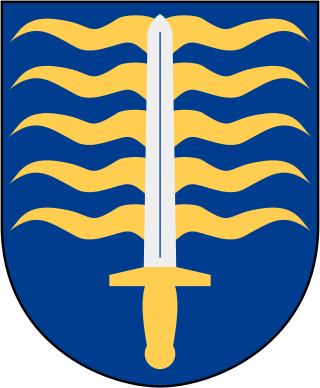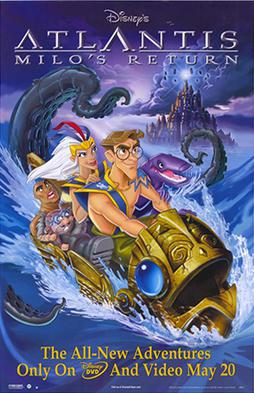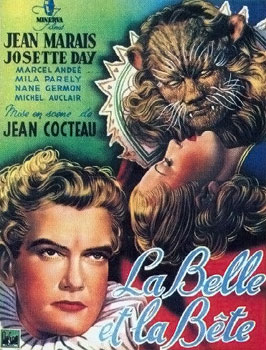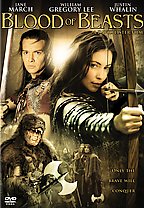
Tyrfing, also rendered as Tirfing or Tyrving, was a magic sword in Norse mythology, which features in the Tyrfing Cycle, which includes a poem from the Poetic Edda called Hervararkviða, and the Hervarar saga. The name is also used in the saga to denote the Goths.

In Norse mythology, the einherjar are those who have died in battle and are brought to Valhalla by valkyries. In Valhalla, the einherjar eat their fill of the nightly resurrecting beast Sæhrímnir, and valkyries bring them mead from the udder of the goat Heiðrún. The einherjar prepare daily for the events of Ragnarök, when they will advance for an immense battle at the field of Vígríðr.

"Beauty and the Beast" is a fairy-tale written by French novelist Gabrielle-Suzanne Barbot de Villeneuve and published in 1740 in La Jeune Américaine et les contes marins.

In mythology, folklore and speculative fiction, shapeshifting is the ability to physically transform oneself through unnatural means. The idea of shapeshifting is found in the oldest forms of totemism and shamanism, as well as the oldest existent literature and epic poems such as the Epic of Gilgamesh and the Iliad. The concept remains a common literary device in modern fantasy, children's literature and popular culture. Examples of shapeshifters are vampires and werewolves.

Erik the Viking is a 1989 British comedy-fantasy film written and directed by Terry Jones. The film was inspired by Jones's children's book The Saga of Erik the Viking (1983), but the plot is completely different. Jones also appears in the film as King Arnulf.

Ynglinga saga is a Kings' saga, originally written in Old Norse by the Icelandic poet and historian Snorri Sturluson about 1225. It is the first section of his Heimskringla. It was first translated into English and published in 1844 by Samuel Laing.
Berserker, also known as Berserker: Hell's Warrior, is a fantasy-action-horror film based on Norse mythology. It was written, directed and produced by Paul Matthews and had its main release in 2004.
Eysteinn Beli or Eysteinn hinn illráði, Swedish: Östen Illråde (ill-ruler) or Östen Beli, was a semi-legendary king of Sweden who would have ruled in the late 8th century.

Sigurd Snake-in-the-Eye or Sigurd Ragnarsson was a semi-legendary Viking warrior and Danish king active from the mid to late 9th century. According to multiple saga sources and Scandinavian histories from the 12th century and later, he is one of the sons of the legendary Viking Ragnar Lodbrok and Áslaug. His historical prototype might have been the Danish King Sigfred who ruled briefly in the 870s. Norwegian kings' genealogies of the Middle Ages name him as an ancestor of Harald Fairhair and used his mother's supposed ancestry to Völsung in order to create an ancestry between Harald and his descendants and Odin.

Atlantis: Milo's Return is a 2003 American animated anthology science fantasy action-adventure film, made of unused TV episodes, directed by Victor Cook, Toby Shelton, and Tad Stones. It is the sequel to Atlantis: The Lost Empire (2001). The film received a direct-to-video release on May 20, 2003.

Beauty and the Beast is a 1946 French romantic fantasy film directed by French poet and filmmaker Jean Cocteau. Starring Josette Day as Belle and Jean Marais as the Beast, it is an adaptation of the 1757 story Beauty and the Beast, written by Jeanne-Marie Leprince de Beaumont and published as part of a fairy tale anthology.
The Norse mythology, preserved ancient Icelandic texts such as the Poetic Edda, the Prose Edda, and other lays and sagas, was little known outside Scandinavia until the 19th century. With the widespread publication of Norse myths and legends at this time, references to the Norse gods and heroes spread into European literary culture, especially in Scandinavia, Germany, and Britain. In the later 20th century, references to Norse mythology became common in science fiction and fantasy literature, role-playing games, and eventually other cultural products such as Japanese animation. Storytelling was an important aspect of Norse mythology and centuries later, with the rediscovery of the myth, Norse mythology once again relies on the impacts of storytelling to spread its agenda.

Valkyrie Profile is a role-playing video game developed by tri-Ace and published by Enix for the PlayStation. It was released on December 22, 1999 in Japan and on August 29, 2000 in North America. Inspired by Norse mythology, Valkyrie Profile follows the titular valkyrie, Lenneth, as she travels through Midgard, collecting the souls of slain heroes to serve either as einherjar or her personal companions for Ragnarok - the battle to decide the fate of all creation - and trains them by fighting monsters and performing additional quests. As she journeys, she learns more about her original human life, removed from her memory upon becoming a Valkyrie.

The Beast is a fictional character who appears in Walt Disney Animation Studios' animated film Beauty and the Beast (1991), as well as in the film's two direct-to-video followups Beauty and the Beast: The Enchanted Christmas and Belle's Magical World. Based on the character from the French fairy tale, the Beast was created by screenwriter Linda Woolverton and animated by Glen Keane.

The Tale of Ragnar's sons is an Old Norse story about Ragnar Lodbrok and his sons.

The Legend of Sigurd and Gudrún is a book containing two narrative poems and related texts composed by English writer J. R. R. Tolkien. It was published by Houghton Mifflin Harcourt and HarperCollins on 5 May 2009.

The characters of the God of War video game franchise belong to a fictional universe based on Greek mythology and Norse mythology. As such, the series features a range of traditional figures, including those from Greek mythology, such as the Olympian Gods, Titans, and Greek heroes, and those from Norse mythology, including the Æsir and Vanir gods and other beings. A number of original characters have also been created to supplement storylines.

The Scarlet Flower, also known as The Little Scarlet Flower or The Little Red Flower, is a Russian literary fairy tale written by Sergey Aksakov. It is a variation of the plot of the fairy tale Beauty and the Beast. In Russia, Beauty and the Beast story is known mostly via Aksakov's retelling.














